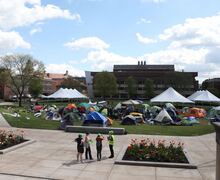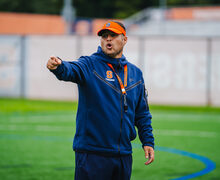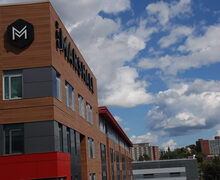College plans for anticipated destruction of Physics Building
Kiran Ramsey | Senior Design Editor
Diversity, inclusion and interdisciplinary research support are among the top priorities in the College of Arts and Sciences’ new Academic Strategic Plan.
Syracuse University’s Physics Building will likely be replaced in coming years as part of a multi-million project that the College of Arts and Sciences is planning for in its new Academic Strategic Plan, the college’s dean said in a recent interview.
The College of Arts and Sciences’ strategic plan, recently released by officials, lists a new “state-of-the art” research space among the college’s goals, along with increasing diversity and support for international students and the humanities. The new academic plan works in tangent with the Campus Framework, a document that outlines short- and long-term development goals of the university.
Karin Ruhlandt, dean of the College of Arts and Sciences, said the school’s strategic plan makes reference to the Physics Building.
“The Campus Framework is actually showing plans with the Physics Building gone, so we need a new one,” Ruhlandt said.
Chancellor Kent Syverud, in a January speech, said all of the university’s schools and colleges now have their individual Academic Strategic Plans drafted. Those plans fall under the university’s overarching Academic Strategic Plan, which has been developed during Syverud’s time as chancellor.
The cost for a new Physics Building is estimated to be between $120 million and $140 million, the dean said, adding that a strong fundraising initiative needs to take place to cover the cost.
The new building would tie into several other initiatives the College of Arts and Sciences has identified in its Academic Strategic Plan, such as peer-led team learning and shared equipment space for research. Peer-led team learning is a method for students to work in a small group, normally six to eight students per group, and complete assignments with a peer leader.
“We need classrooms without fixed seating so that people can work in groups,” Ruhlandt said. “We would like to build classrooms that are highly flexible to allow for all different sorts of learning.”
The shared equipment space, maintained by a full-time staff, would provide faculty members access to expensive materials for their research, Ruhlandt said.
The College of Arts and Sciences is also seeking to hire new grant coordinators to support humanities faculties, according to its strategic plan. Ruhlandt said that, even though the university is already well-equipped to secure funding through National Science Foundation and National Institute of Health grants, SU lacks the expertise in funding for humanities research.
“We need to help faculty to increase the chances to get such funding,” Ruhlandt said. “Funding in the humanities sector is incredibly competitive.”
The strategic plan, Ruhlandt said, calls for hiring an associate dean for inclusion and diversity because that is a major focus of the college.
The dean said the associate dean’s responsibilities would include paying attention to tasks such as the faculty hiring process and eliminating unconscious bias in the College of Arts and Sciences.
Ruhlandt also said international students contribute to diversity efforts at the university. The college’s Academic Strategic Plan states that the college aims to create a language support office to assist international students and an English-only language lounge for all students of all backgrounds to interact and increase English communication skills.
“We really feel that through paying close attention to creating a diverse and inclusive environment we will be enhancing the student experience and the scholarship,” Ruhlandt said.
Published on March 28, 2018 at 9:51 pm




